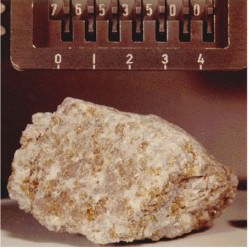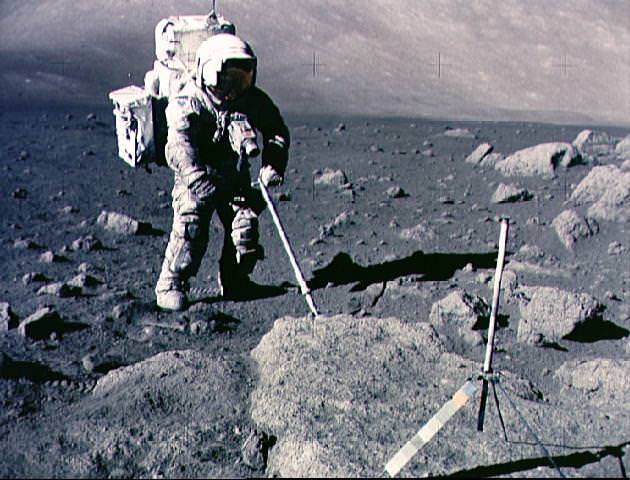[/caption]
Back in the 1960’s and ’70’s when scientists claimed that the Moon rocks returned by the Apollo astronauts would keep researchers busy for decades, they weren’t kidding. Analysis on one of the rocks collected during the Apollo 17 mission has helped to solve a longstanding puzzle about the Moon. Researchers at the Massachusetts Institute of Technology (MIT) carried out the most detailed analysis ever of the oldest pristine rock from the Apollo collection. Magnetic traces recorded in the rock provide strong evidence that 4.2 billion years ago the moon had a liquid core with a dynamo, like Earth’s core today, that produced a strong magnetic field.
Until the Apollo Moon missions, many scientists were convinced the moon was born cold and stayed cold, never melting enough to form a liquid core. Apollo proved that there had been massive flows of lava on the moon’s surface, but the idea that it has, or ever had, a molten core remained controversial. “People have been vociferously debating this for 30 years,” said Ben Weiss, Assistant Professor of Planetary Sciences in MIT’s Department of Earth, Atmospheric and Planetary Sciences and senior author of a paper on the new finding being published in Science on Jan. 16.
Many of the rocks returned from the Moon had magnetic qualities, which was perplexing to scientists. How could Moon rocks be magnetic if the Moon had no magnetic core?
One rock in particular was compelling. The rock was collected on Apollo 17, the last Apollo mission to the moon, by Harrison “Jack” Schmidt, the only geologist ever to walk on the moon. “Many people think that it’s the most interesting lunar rock,” said Weiss.

“It is one of the oldest and most pristine samples known,” said graduate student Ian Garrick-Bethell, who was the lead author of the Science paper. “If that wasn’t enough, it is also perhaps the most beautiful lunar rock, displaying a mixture of bright green and milky-white crystals.”
The team studied faint magnetic traces in a small sample of the rock in great detail. Using a commercial rock magnetometer that was specially fitted with an automated robotic system to take many readings “allowed us to make an order of magnitude more measurements than previous studies of lunar samples,” Garrick-Bethell said. “This permitted us to study the magnetization of the rock in much greater detail than previously possible.”
And those data enabled them to rule out the other possible sources of the magnetic traces, such as magnetic fields briefly generated by huge impacts on the moon, which are very short-lived. But the evidence written in the lunar rock showed it must have remained in a magnetic environment for a long period of time — millions of years — and thus the field had to have come from a long-lasting magnetic dynamo.
That’s not a new idea, but it has been “one of the most controversial issues in lunar science,” Weiss said.
The magnetic field necessary to have magnetized this rock would have been about one-fiftieth as strong as Earth’s is today, Weiss said. “This is consistent with dynamo theory,” and also fits in with the prevailing theory that the moon was born when a Mars-sized body crashed into the Earth and blasted much of its crust into space, where it clumped together to form the moon.
The new finding underscores how much we still don’t know about our nearest neighbor in space, and which will soon be visited by humans once again under current NASA plans. “While humans have visited the moon six times, we have really only scratched the surface when it comes to our understanding of this world,” said Garick-Bethell.
Source: MIT


4.2 Billion years ago Moon was too close to the Earth and the earth was largely molten inside. The magnetic fields must have been stonger and might have interacted between the two bodies.
Who knows earth might have magnetised the moon rocks.
How far into the future and how far away would the moon have to travel to escape Earth’s gravity? I know that the moon is slowly and gradually moving away from us, I just don’t know at what rate.
It is always influenced by the gravity of Earth even at the other side of the universe privided you give enough time for gravity to travel the distance.
But at one point some other body will have a bigger influence on the moon than earth and then it moves away faster.
@ eric
I don’t remember the exact rate, but I know it will take a very long time… I think it’s measured on the tens to hundreds of millions of years.
@ Bill L.
Thanks for the answer. I guess all I need to put it into perspective is that the Earth and Moon collided 4.2 billion years ago and they’re just 300,000+ miles away now. Chances are it’ll go to 600,000+ miles away by the time the Sun has it’s last hurrah in 4-5 billion years, unless the distance increases faster – similar to the universe’s expansion. Now the question is, would that be enough distance to break the bond between the Earth and the Moon?
Barring some extraordinary circumstances the Moon will never leave Earth orbit. It’s average orbital distance increases by 3-4 cm per year and will continue until the tidal interaction becomes negligible. Current estimates suggest it should stabilize at approximately 1.6 times it’s current distance over a period of 15 billion years. Of course the Sun and the rest of the Solar System won’t be around quite that long.
read the paper in Science
Early Lunar Magnetism
came out today
The Moon is retreating from the Earth 1- 1/2 inches per year.
In 100 million years it won’t have any effect on Earth and humans won’t be around to miss the eclipses either.
if that’s true than the creatures who follow us will not have the tides in the oceans and the earth will be different from any time in the past. Complex life may not be possible without the tidal effect of the moon to mix the oceans. no more saber tooth tigers.
“The Moon will not leave the Earth’s gravity, even though the orbit of the Moon is increasing slightly. The Earth’s rotation is slowing down (due to “tidal braking”), and to conserve angular momentum the Moon is accelerating. The Moon’s orbit increases by about 3 cm/year.
The Earth and the Moon eventually will be “locked” together with each only having one side constantly facing the other. (Right now the same side of the Moon faces the Earth, but all sides of the Earth see the Moon. In the future this will not be true!) Life on Earth will be quite different then, but this won’t occur for billions of years yet. When it does occur, the Moon’s orbit will be 50% larger than it is now, and a month will be about 50 days.” -Dr. Louis Barbier
There’s your answer.